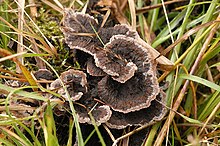| Thelephora terrestris | |
|---|---|

| |
| Scientific classification | |
| Domain: | Eukaryota |
| Kingdom: | Fungi |
| Division: | Basidiomycota |
| Class: | Agaricomycetes |
| Order: | Thelephorales |
| Family: | Thelephoraceae |
| Genus: | Thelephora |
| Species: | T. terrestris |
| Binomial name | |
| Thelephora terrestris Ehrh. (1787) | |
Thelephora terrestris, commonly known as the common fiber vase or earthfan fungus is an inedible species of fungus in the Basidiomycota phylum.
History and taxonomy
This fungus was first described by Jakob Friedrich Ehrhart in 1787.
Habitat and ecology
Throughout North America and Europe Thelephora terrestris can be found in soil. It is commonly found in sandy soils under pine trees, on roots and twigs.
This ectomycorrhizal fungus forms a symbiotic relationship known as mycorrhizae, especially with Pinus species. It is commonly found in pine forests as well as plant nursery soils world wide. This fungus is known to get water and nutrients from far away and being capable of growing in both low fertility and high fertility soils.
It is a dominant mycorrhizal fungus, re-establishes quickly after disturbances such as forest fire, and is considered stress tolerant.
Outside of the Pinus genus, it is also capable of forming mycorrizha with other trees such as alder, birch, oak, beech, and poplar.
Thelephora terrestris virus 1 (TtV1), which is a mycovirus, can infect this fungus.
Description
Thelephora terrestris is present year round, though is mostly seen July to December. As the fruiting body forms, it starts off lighter in colour then turns to a darker shade of brown as it ages. A stalk may not be present, if there is one, it is usually very short. Sometimes the fungus is grown in large colonies. The shape is described as a fan and can grow up to 6 cm wide. It has been described to have a moldy earth like smell.
Species of fungus| Thelephora terrestris | |
|---|---|
| Smooth hymenium | |
| No distinct cap | |
| Hymenium attachment is not applicable | |
| Stipe is bare | |
| Spore print is purple-brown | |
| Ecology is mycorrhizal | |
| Edibility is inedible | |
The hyphae of mycorrhizal forms walls that becomes thicker as it ages, while in earlier stages may be spiney. When mating, the hyphae forms clamp connections The spores are purple-brown colour, ellipsoid or angular shape.
The edibility of this fungus is unknown, but it is considered too tough to be worthwhile.
Thelephora palmata is a similar species which is comparatively stinky and less widely distributed.
Physiology
The full life cycle can be reproduced and studied in a laboratory, both ectomycorrhizal form and mushroom form.
Due to the mycotoxins that the fungi produces, it protects pinus trees from root pathogen Phytophthora cinnamomi.
References
- ^ National Audubon Society field guide to North American mushrooms. Knopf. 1981. p. 413. ISBN 0-394-51992-2.
- ^ Petrzik, Karel; Sarkisova, Tatiana; Starý, Josef; Koloniuk, Igor; Hrabáková, Lenka; Kubešová, Olga (February 2016). "Molecular characterization of a new monopartite dsRNA mycovirus from mycorrhizal Thelephora terrestris (Ehrh.) and its detection in soil oribatid mites (Acari: Oribatida)". Virology. 489: 12–19. doi:10.1016/j.virol.2015.11.009. PMID 26700067.
- Radulović, Niko; Quang, Dang Ngoc; Hashimoto, Toshihiro; Nukada, Makiko; Tanaka, Masami; Asakawa, Yoshinori (2005). "Pregnane-Type Steroids from the Inedible Mushroom Thelephora terrestris". Chemical & Pharmaceutical Bulletin. 53 (3): 309–312. doi:10.1248/cpb.53.309. PMID 15744104.
- "Mycobank: Thelephora terrestris". Mycobank. Retrieved 2021-02-19.
- ^ Burt, Edward Angus (May 1914). "The Thelephoraceae of North America. I". Annals of the Missouri Botanical Garden. 1 (2): 185–227. doi:10.2307/2989992. JSTOR 2989992.
- ^ Ellis, Martin B.; Ellis, J. Pamela (1990). Fungi without gills (hymenomycetes and gasteromycetes) : an identification handbook (1st ed.). Britain: Chapman and Hall. ISBN 0-412-36970-2.
- ^ López-Gutiérrez, Araceli; Perez-Moreno, Jesus; Hernández-Santiago, Faustino; Uscanga-Mortera, Ebandro; García-Esteva, Antonio; Cetina-Alcalá, Victor Manuel; Cardoso-Villanueva, María del Rosario; Xoconostle-Cázares, Beatriz (19 June 2018). "Nutrient mobilization, growth and field survival of Pinus pringlei inoculated with three ectomycorrhizal mushrooms". Botanical Sciences. 96 (2): 286. doi:10.17129/botsci.1239.
- Moeller, Holly V.; Peay, Kabir G. (27 July 2016). "Competition-function tradeoffs in ectomycorrhizal fungi". PeerJ. 4: e2270. doi:10.7717/peerj.2270. PMC 4974999. PMID 27547573.
- ^ Smith, Sally E; Read, David J (2002). Mycorrhizal Symbiosis. Academic Press. pp. 470–489. doi:10.1016/B978-012652840-4/50018-8.
- Hilszczańska, Dorota; Małecka, Monika; Sierota, Zbigniew (January 2008). "Changes in nitrogen level and mycorrhizal structure of Scots pine seedlings inoculated with Thelephora terrestris" (PDF). Annals of Forest Science. 65 (4): 409. doi:10.1051/forest:2008020. S2CID 21922463.
- Veselá, Petra; Vašutová, Martina; Edwards-Jonášová, Magda; Cudlín, Pavel (29 January 2019). "Soil Fungal Community in Norway Spruce Forests under Bark Beetle Attack". Forests. 10 (2): 109. doi:10.3390/f10020109.
- Agerer, R.; Weiss, M. (29 August 2018). "Studies on Ectomycorrhizae. XX. Mycorrhizae Formed by on Norway Spruce". Mycologia. 81 (3): 444–453. doi:10.1080/00275514.1989.12025766.
- ^ Davis, R. Michael; Sommer, Robert; Menge, John A. (2012). Field Guide to Mushrooms of Western North America. Berkeley: University of California Press. pp. 310–311. ISBN 978-0-520-95360-4. OCLC 797915861.
- Trudell, Steve; Ammirati, Joe (2009). Mushrooms of the Pacific Northwest. Timber Press Field Guides. Portland, OR: Timber Press. p. 253. ISBN 978-0-88192-935-5.
- Birraux, D.; Fries, N. (November 1981). "Germination of basidiospores". Canadian Journal of Botany. 59 (11): 2062–2064. doi:10.1139/b81-267.
| Taxon identifiers | |
|---|---|
| Thelephora terrestris |
|